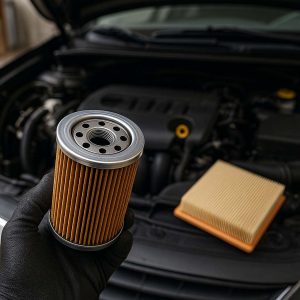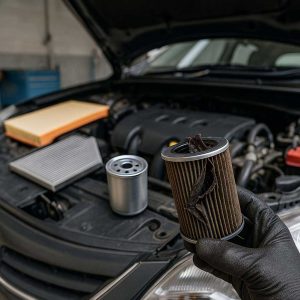Filters may be small, but from a mechanic’s point of view, they play a massive role in engine health. Whether it’s the oil, air, fuel, or cabin filter, choosing the wrong type, size, or quality can result in costly damage to your engine and its components. As any experienced technician will tell you, a cheap or incorrect filter can cost far more in repairs than a quality one does in prevention.
In this article, we’ll explore the risks of using the wrong filters, how they can damage your engine, and what to watch out for when selecting replacements.
1. The Role of Each Filter in Engine Protection

Every automotive filter has a unique job to ensure smooth engine function and protection:
| Filter Type | Function |
|---|---|
| Engine Air Filter | Keeps dirt and debris from entering the combustion chamber. |
| Oil Filter | Captures metal particles, sludge, and impurities from engine oil. |
| Fuel Filter | Prevents rust, sediment, and contaminants from entering the injectors or carburetor. |
| Cabin Filter (indirect impact) | Improves air quality inside the car; dirty filters may stress HVAC systems, affecting power draw. |
2. Common Mistakes Mechanics See with Filters
From real-world workshop experience, here are some of the most frequent filter-related issues:
Wrong Size or Fitment
A filter that doesn’t fit properly can allow unfiltered material into the engine.
-
Oil filters that don’t seal correctly may bypass filtration, recirculating dirty oil.
-
Ill-fitting air filters leave gaps, pulling dust and debris into the intake manifold.
Incorrect Filtration Rating
Filters vary in how fine the particles they can trap.
-
A low-grade fuel filter may allow rust or dirt to clog injectors.
-
A poor oil filter may fail to catch micro-metal shavings after engine wear or repairs.
Blocked or Overused Filters
Clogged filters restrict flow of air, oil, or fuel, making the engine work harder.
| Effect of Clogged Filter | Component Affected | Possible Damage |
|---|---|---|
| Restricted air intake | Engine combustion | Poor performance, misfires |
| Oil starvation | Bearings, camshaft | Accelerated wear, seizure |
| Fuel flow reduction | Injectors, pump | Engine hesitation, lean mix |
3. Real-World Damage: Mechanic Case Studies
Here are a few real examples from service bays:
Case 1: Air Filter Too Small
Issue: Aftermarket filter with poor fitment left a 2mm gap in the housing.
Result: Fine dust entered the intake, scoring the cylinder walls.
Repair Cost: Engine rebuild ~€2,000+
Case 2: Cheap Oil Filter Collapsed
Issue: Budget oil filter collapsed internally during cold weather.
Result: Oil bypassed filtration, contaminating bearings and lifters.
Repair Cost: Full engine teardown and cleaning ~€1,500
Case 3: Fuel Filter Not Replaced On Time
Issue: Fuel filter clogged, causing fuel pressure drops.
Result: Poor combustion, ECU fault codes, injector damage.
Repair Cost: Injector replacement ~€800
4. Key Symptoms of Using the Wrong Filter
Watch out for these warning signs:
| Symptom | Likely Filter Issue |
|---|---|
| Reduced acceleration | Clogged air or fuel filter |
| High engine temperature | Restricted oil or coolant flow |
| Engine knocking or ticking | Unfiltered oil contaminants |
| Check engine light | Fuel pressure or airflow problems |
| Rough idle or stalling | Fuel or air filter restriction |
5. The Long-Term Cost of the Wrong Filter
Using the wrong or cheap filter may save money upfront but typically leads to bigger expenses:
| Filter Type | Cheap Option Consequence | Potential Engine Damage |
|---|---|---|
| Air Filter | Dust ingestion | Cylinder scoring, valve wear |
| Oil Filter | Unfiltered oil | Bearing damage, sludge buildup |
| Fuel Filter | Poor filtration or clogging | Injector wear, fuel pump strain |
| Cabin Filter | Less engine-related, but dirty HVAC systems may affect power draw |
6. Best Practices from the Workshop
As a mechanic, here’s what I recommend to every car owner:
Match OEM Specifications
Always choose filters that match or exceed the manufacturer’s specs. Don’t “eyeball” fitment—check part numbers or use trusted online compatibility tools.
Stick to Known Brands
Brands with verified quality testing are worth the investment. Look for filters with multi-layer media, metal end caps, and anti-drain-back valves in oil filters.
Replace on Schedule
Even the best filter becomes a liability if left in too long.
| Recommended Replacement Intervals |
|---|
| Engine air filter: 15,000–30,000 km |
| Oil filter: Every oil change (5,000–15,000 km) |
| Fuel filter: 40,000–80,000 km |
| Cabin filter: 15,000–25,000 km |
7. When Upgrades Make Sense

Sometimes, upgrading beyond OEM is beneficial:
-
High-performance engines: Use high-flow air filters (with caution) or synthetic oil filters.
-
Dusty environments: Multi-stage air filters prevent dirt ingestion.
-
Cold climates: Oil filters with silicone anti-drain-back valves perform better in cold starts.
8. Where to Find the Right Filters
Looking for reliable, climate- and model-appropriate filters? Make sure you’re buying quality parts from a trusted supplier.
Buy Car Filters online — Explore air, oil, fuel, and cabin filters for every vehicle and climate. Filter by brand, model, and quality to ensure the perfect fit.
Final Thoughts: Cheap Filter = Expensive Mistake
From a mechanic’s perspective, nothing frustrates us more than avoidable damage caused by a wrong filter. It’s a classic example of “penny wise, pound foolish.” A poor or ill-fitting filter may seem harmless but can silently compromise your engine’s integrity.
Always choose filters with care, replace them on time, and don’t cut corners with quality. Your engine, your wallet, and your future self will thank you.